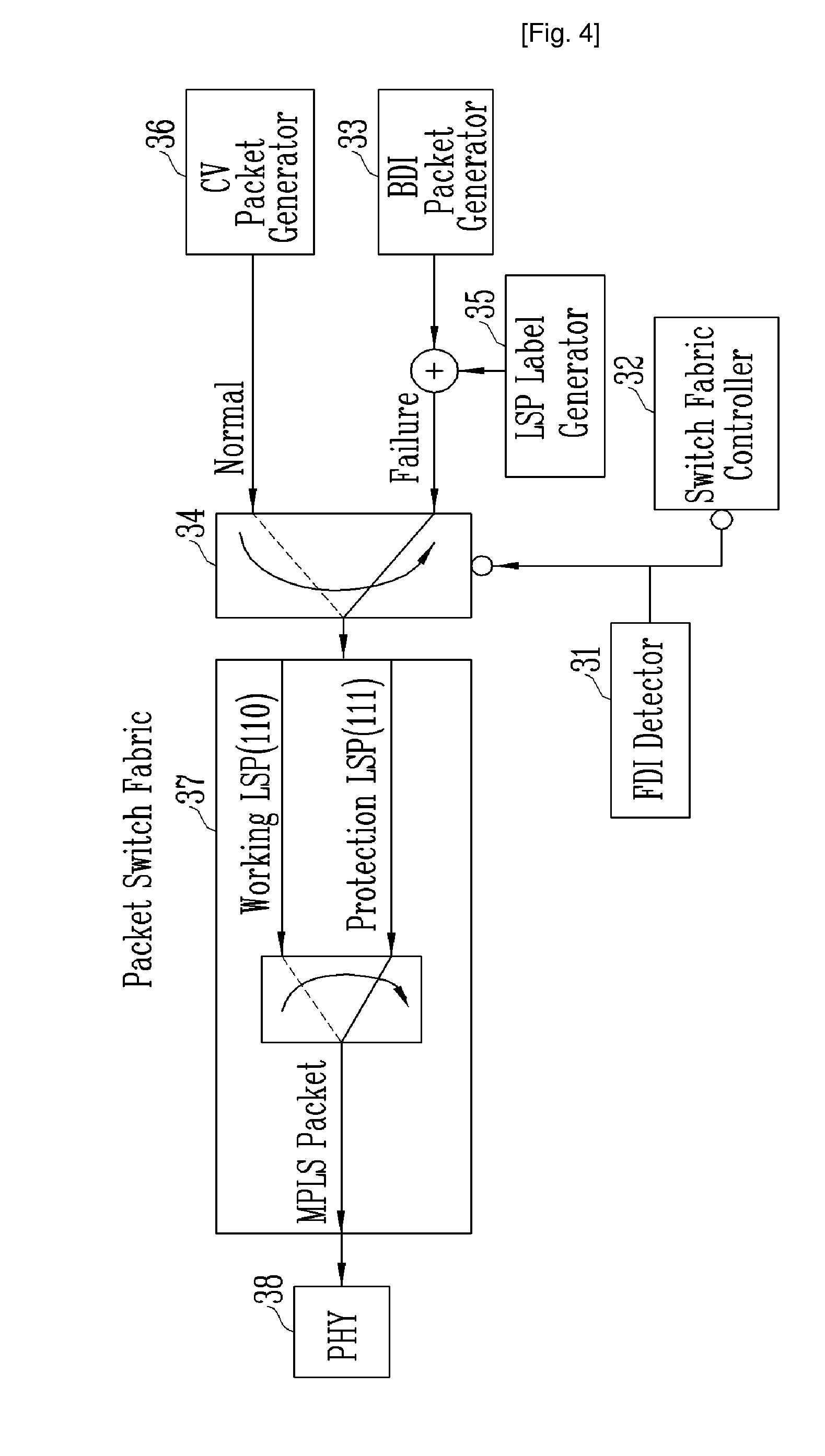Apparatus and Method for Multi-Protocol Label Switching Label-Switched Path Protection Switching
- Summary
- Abstract
- Description
- Claims
- Application Information
AI Technical Summary
Benefits of technology
Problems solved by technology
Method used
Image
Examples
first embodiment
[0048]FIG. 3 is a block diagram illustrating a first embodiment of inserting an FDI signal at a transit node when a failure occurs on an MPLS LSP, according to the present invention.
[0049]Referring to FIG. 3, when a failure occurs between the ingress node 101 and the transit node 103, the failure is detected, and the FDI signal is inserted by the transit node 103 in a hardware way.
[0050]More specifically, when no failure occurs on the MPLS LSP, the FDI insertion switch 22 selects a “normal” state, so that an MPLS packet is switched by the packet switching fabric 25. Then, the MPLS packet is subjected to label swapping by the label swapper 26 and transmitted to the next node through the PHY 27.
[0051]However, when the failure occurs on the MPLS LSP, the failure detector 21 controls the FDI insertion switch 22 to select a “failure” state. Here, the FDI packet generator 23 generates an FDI / BDI OAM packet at periods of 3 ms or less, as shown in FIG. 6. The LSP label generator 24 generate...
second embodiment
[0058]FIG. 4 is a block diagram showing an embodiment of inserting FDI in a BDI packet at an egress node, according to the present invention.
[0059]Referring to FIG. 4, the FDI detector 31 receives an MPLS packet that is transmitted from the transit node 103 as in the first embodiment, and detects an FDI packet. Here, when the FDI packet is detected by the FDI detector 31, it is recognized that a failure occurs at the transit node 103. Thereby, the BDI insertion switch 34 is controlled.
[0060]More specifically, in a normal state, the BDI insertion switch 34 selects an output signal of the CV packet generator 36 in order to monitor a connection state of the return path 113. Here, the CV packet generator 36 periodically generates the CV or FFD packet, and sets the generation period of the CV to a time 1 sec and that of the FFD from 10 ms to 500 ms adjusted by 10 ms.
[0061]The BDI packet generator 33 generates a packet as shown in FIG. 6. Here, a defect location (DL) indicating a location...
third embodiment
[0078]FIG. 2 illustrates an embodiment of multicasting an MPLS packet to a working LSP and a protection LSP at an ingress node according to the present invention.
[0079]Referring to FIG. 2, the BDI detector 12 receives a BDI OAM packet transmitted from the egress node 102 as in Second Embodiment, and detects a BDI packet. Here, when the BDI packet is detected by the BDI detector 12, it is determined that the failure occurs at the egress node 102. Thereby, the multicasting switch 14 is controlled to multicast an MPLS packet to the working LSP 110 and the protection LSP 111, thus performing a protection switching function related to a transmission unit.
[0080]By using the multicasting switch 14 in this way, the same effect as in a 1:1 switching method of synchronous digital hierarchy (SDH) / synchronous optical network (SONET) that bridges traffic to be protected to a working link and a protection link is obtained.
[0081]FIG. 9 is a flowchart illustrating a process of controlling a multica...
PUM
 Login to View More
Login to View More Abstract
Description
Claims
Application Information
 Login to View More
Login to View More - R&D
- Intellectual Property
- Life Sciences
- Materials
- Tech Scout
- Unparalleled Data Quality
- Higher Quality Content
- 60% Fewer Hallucinations
Browse by: Latest US Patents, China's latest patents, Technical Efficacy Thesaurus, Application Domain, Technology Topic, Popular Technical Reports.
© 2025 PatSnap. All rights reserved.Legal|Privacy policy|Modern Slavery Act Transparency Statement|Sitemap|About US| Contact US: help@patsnap.com



